Predictable Dentistry in a Busy World – Everyone Wins!
In years past, placing direct composite resin restorations required a multitude of inefficient technique-sensitive steps from bonding, incremental layering and curing to manipulation of the composite materials. Fortunately, advancements in direct composite materials and technology along with improvements in instrumentation have resulted in a streamlined direct composite process that is optimized to shorten treatment times, minimize polymerization shrinkage and tooth sensitivity, while offering us the ability to do more and better dentistry in less time without compromising the esthetics and longevity of the final outcome.
Today, we have fully coordinated products and systems such as Ivoclar’s Efficient Esthetic Workflow that offer a family of products, optimized to work together to streamline the direct composite restorations in the posterior without sacrificing the esthetics of the final restoration. Tetric PowerFlow and Tetric PowerFill work together to minimize the polymerization shrinkage that in the past caused tooth sensitivity and marginal breakdown. New curing technology such as the Bluephase PowerCure can now cure a 4mm layer of composite in only 3 seconds, saving valuable time and eliminating the once technique-sensitive multi-layer protocol while new non-stick sculpting and polishing tools help shorten placement and finishing of the final restoration.
In the case presented here, a 53-year-old male patient presented to the practice to replace the aging amalgam restorations in his lower arch. At a previous appointment failing amalgam restorations, which had caused tooth sensitivity on teeth #18 and #19, had been replaced with all-ceramic direct composite and, on advice of the clinician, he decided also to restore teeth #30 and #31 (Figures 1 and 2) before they too failed.
Figures 1 and 2 (below): A patient presented to the practice to remove old amalgam restorations and restore with an esthetic all-ceramic solution.
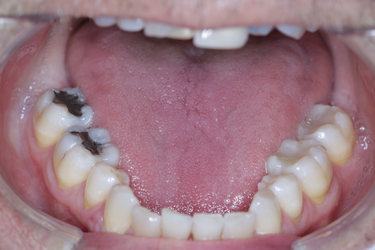
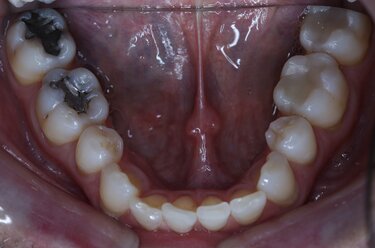
The patient was anesthetized and the operative site isolated with a rubber dam clamped in place (Figure 3) to minimize contamination of the site. Teeth #30 and #31 were prepared (Figure 4), removing the existing amalgam restorations and any underlying caries. Angles of the preparation were refined to maintain the integrity of the tooth structure and retain as much enamel as possible for a durable restoration. The preparations were air-abraded (Prep-Start Danville Engineering) using 27-micron aluminum oxide at 40 psi to hybridize the dentin to help increase the bond strength of the composite to the tooth enamel (Figure 5). The preparations were then rinsed and cleaned and disinfected with a 2.0% chlorhexidine gluconate antibacterial slurry (Consepsis Scrub, Ultradent).
After the preparations were thoroughly cleaned and disinfected, a single component 37% phosphoric acid etch material (Etch-37 wBAC, Bisco) was applied to the enamel of both teeth (Figure 6) and air-dried to ensure a strong marginal seal of the composite to the enamel. A universal adhesive (Adhese Universal, Ivoclar) was then scrubbed onto the cavity walls of each tooth (Figure 7), air-dried and cured (BluePhase PowerCure, Ivoclar) for 3 seconds (Figure 8).
Next, a single layer of flowable composite (Tetric PowerFlow, Ivoclar) was applied to line the internal aspects of the cavity and light cured for 3 seconds (Figure 9). Next, a single layer of flowable composite (Tetric PowerFlow, Ivoclar) was applied to line the internal aspects of the cavity and light cured for 3 seconds (Figure 9). The flowable composite ensures a complete seal of the dentin against microleakage and recurrent caries and helps eliminate the stress of polymerization shrinkage. In addition, during the curing process, the high translucency of the flowable material gradually changes to a more opaque shade that is closer to that of natural dentin in value and will conceal the stained underlying tooth structure to optimize the esthetics of the final restoration.
The internal depth of each tooth was then measured with a periodontal probe (Figure 10) to verify that the depth of each cavity was not more than 4mm in depth, which is essential when using a single cure bulk restorative material. A single 4mm layer of a bulk fill composite (Tetric PowerFill IVW, Ivoclar) was placed in each tooth (Figure 11).
An adhesive (Excite F, Ivoclar) (Figure 12) is applied to the condensing tool (Heliomolar P1 Plugger, Ivoclar) (Figure 13) to help glide the tool smoothly across the bulk fill composite as it is compressed to remove any air bubbles. Final anatomy is sculpted (Figures 14 and 15) using a contouring instruments (OptraSculpt, Ivoclar) (Figure 16).
Figures 12 and 13 (below): An adhesive was applied to the condensing tool for compressing the composite to remove any air bubbles.
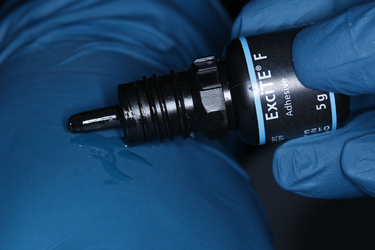
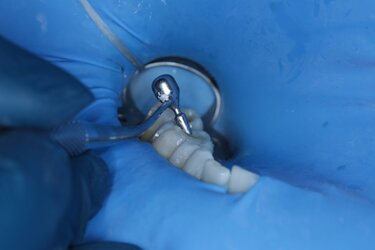
Figures 14-16 (below): Final anatomy is sculpted using contouring instruments and the composite light-cured for 3 seconds.
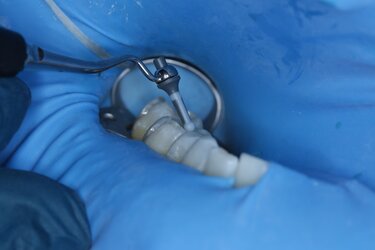
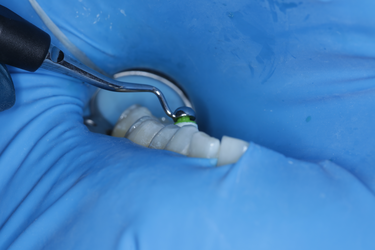
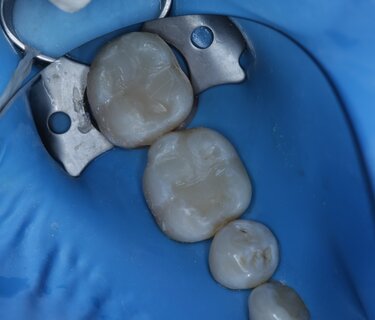
The composite fillings were light-cured for the manufacturer-recommended 3 seconds. Once curing and occlusal adjustments were made, the restorations were finished and polished using silicone polishers (OptraGloss, Ivoclar) (Figures 17). Figure 18 shows the esthetic restorations immediately after treatment and after rehydration (Figure 19). The patient was pleased with the esthetic outcome
Figure 17 (below, left): The restorations were finished and polished with silicone polishers.
Figure 18 (below, right): The restorations immediately after treatment.
Figure 19 (bottom image): The restorations in the mouth after rehydration.
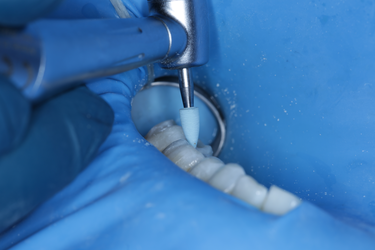

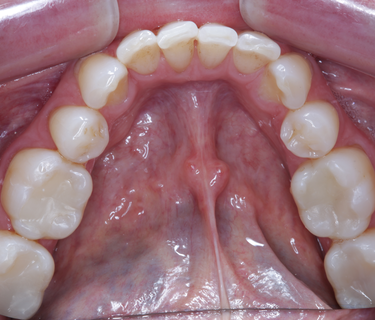
From a business perspective the ability to use materials and tools optimized to streamline the most common procedure performed in any dental operatory offers my practice a time savings that equates to serving more patients, increasing the profitability of the practice, and satisfying the desire of patients to get in and out of the chair in a timely fashion. It’s a win-win for both the business and the patient.
Receive our monthly newsletter on recently published blog articles, upcoming education programs and exciting new product campaigns!
